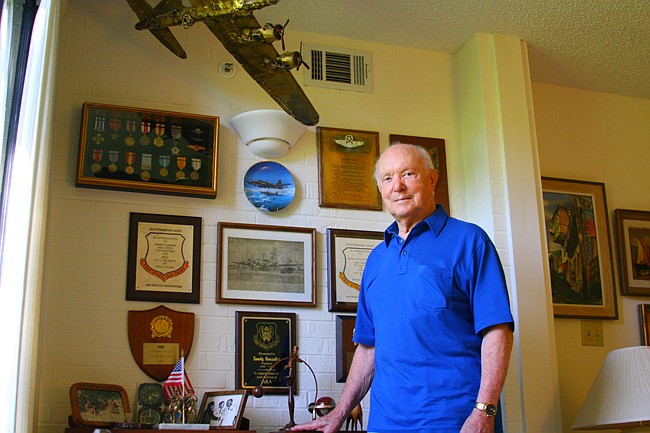- April 26, 2024
-
-
Loading

Loading

Sandy Gonzalez was one of those boys who built model airplanes at night and by day searched the skies for the real things, watching for them as one might for shooting stars. He caught the aviation bug at an early age and spent nearly every waking moment dreaming of the day when he could get his wings.
After a difficult early childhood, some of which was spent in a Catholic group home, Gonzalez found his place at the Manhattan High School of Aviation. In the early 1940s it was a specialized school for boys in New York City who were eager to join the ranks of young men going into the growing field of aviation.
There were classes for boys interested in becoming pilots, navigators or even flight mechanics. Gonzalez had no doubts about where he wanted to land: the pilot’s seat.
He graduated early, at age 17, and took a job with the Army Air Corps Cadet program in Middleton, Penn. While he was waiting to turn 18 so he could enlist, the U.S. was waging war on Japan and Germany following the assault on Pearl Harbor Dec. 7, 1941.
Shortly after his 18th birthday in May 1943, the long awaited call came in and it was off to basic training followed by flight school.
Then it was on to bomber training in Sebring, where he learned to pilot the B-17, a popular WWII bomber that carried a crew of 10.
Following bomber training, Gonzalez joined the Eighth Air Force in flight over England, and successfully completed 30 bombing missions. An incredible feat, as anyone who has ever seen “Memphis Belle” can attest.
“I was always in the right place at the right time,” Gonzalez said. “It was just good timing for the most part that kept me safe.”
Throughout the remainder of the war, Gonzalez flew missions with the fledgling Air Rescue unit, whose job it was to pick up downed pilots or troops who had strayed off course.
After the war, he was stationed in West Palm Beach, and remained with the Air Rescue service helping develop protocols and train pilots for missions.
There he began flying the Grumman Albatross Seaplane, which was capable of landing in the open ocean under all sorts of harrowing conditions – including rescuing a downed pilot off of a rocky beach on the shore of Canada.
“The pilot managed to land on the beach, but it was too short to take off, so we came in and rescued him. The only way we could take off though, was to use JATO, or Jet Assisted Take Off canisters. We had four on board, two for each side that generated 4,000 pounds of thrust, more than enough to see us safely off the small beach,” he said.
On another mission, Gonzalez recalled rescuing a fellow soldier from a river at night under enemy fire.
The motto of the Air Rescue unit reads “So that others may live,” a self-sacrificing attitude that pilots like Gonzalez never took lightly.
He and his fellow pilots and crewmen risked their own lives on every mission, but he said they always considered it their personal duty to bring back every missing member they could.
“I was always proud that I never lost a crewmember,” Gonzalez said.
Through various assignments both at home and abroad, Gonzalez continued to serve honorably throughout his 29-year career with the Air Force. He performed air rescue missions in WWII, Korea, Vietnam as well as hundreds of peacetime missions. He retired with the rank of Colonel and moved to Gainesville to be near his children, who were attending the University of Florida at the time.
A few years later, Gonzalez and his wife moved to Fern Park, where they lived together for 30 years, until his wife’s passing in 2000.
Today Gonzalez makes his home in the Village on the Green in Longwood. At 88, he still lives independently. In fact, he would outdo many people half his age on the computer, managing the Air Rescue Association’s website and serves as the group’s executive director.
Over the years, Gonzalez has seen many a friend take their final flight, and been there to help others fly another day. And that, he said, is why he feels so strongly about maintaining the camaraderie of his fellow aviators.
He has dedicated much of his retirement as president, then as executive director, of the Air Rescue Association, heading annual reunions, updating newsletters and helping former, current and future members of Air Rescue units stay in touch and reconnect whenever possible.
“It’s not always easy running all this, but it’s important to me and to the members to keep it all going,” he said. “It’s how we connect and share the bonds that we all have.”